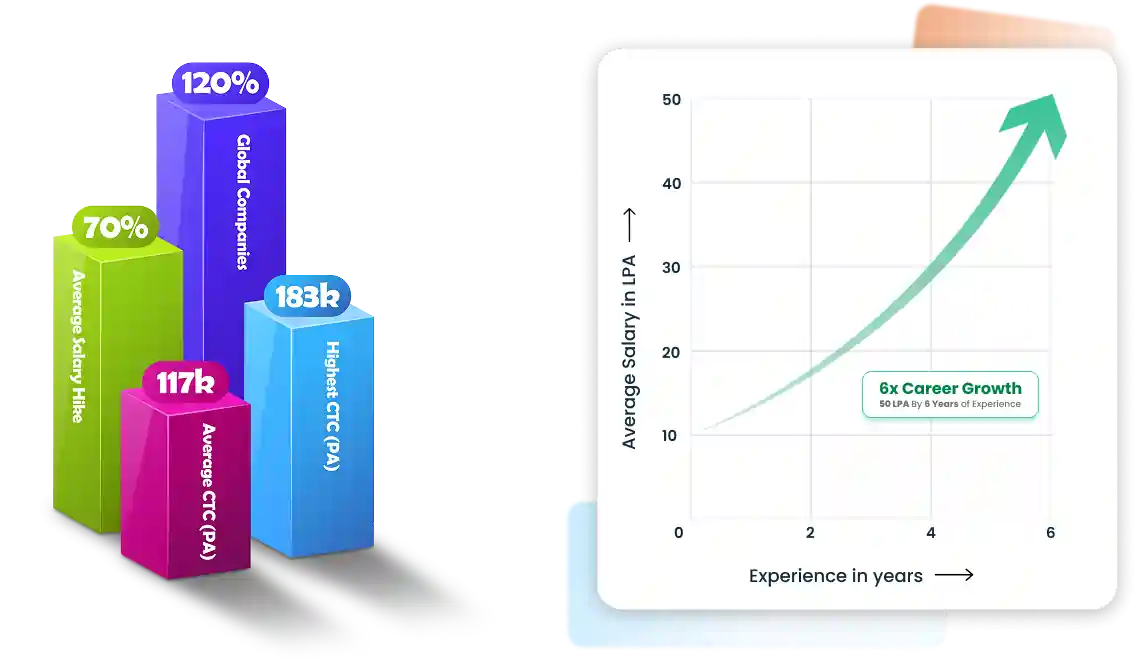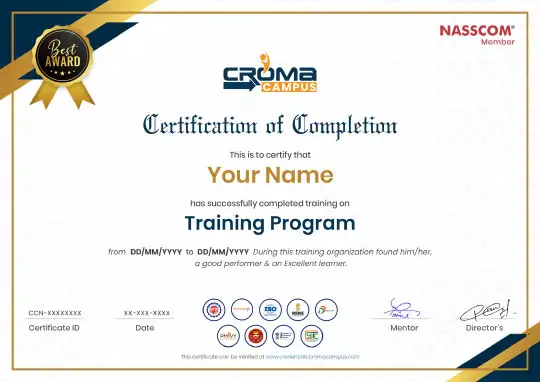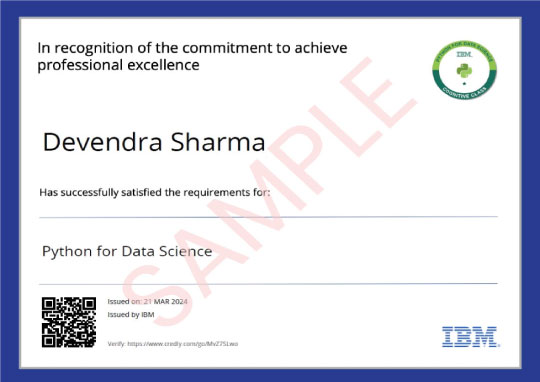Course Design By
Nasscom & Wipro
Starting at
Register Now
And Get
10%
OFF
Limited Time Offer*
What is Data Analytic
Common Terms in Data Analytics
What is data
Classication of data
Relevance in industry and need of the hour
Types of problems and business objectives in various industries
How leading companies are harnessing the power of analytics
Critical success drivers.
Overview of Data Analytics tools & their popularity.
Data Analytics Methodology & problem-solving framework.
List of steps in Data Analytics projects
Introduction To Python
Python Keyword and Identiers
Introduction To Variables
Python Data Type
Control Structure & Flow
Python Function, Modules and Packages
List
Tuple
Dictionary
Sets
Strings
Python Exception Handling
Python File Handling
Python Database Interaction
Reading an excel
Complete Understanding of OS Module of Python
Data Analysis and Visualization using Pandas.
Data Analysis and Visualization using NumPy and MatPlotLib
Introduction to Data Visualization with Seaborn
Introduction to Statistics
Data Pre-Processing & Data Mining
EDA (Exploratory Data Analysis)
SQL Server Fundamentals
SQL Server 2019 Database Design
SQL Tables in MS SQL Server
Data Validation and Constraints
Views and Row Data Security
Indexes and Query tuning
Stored Procedures and Benets
System functions and Usage
Triggers, cursors, memory limitations
Cursors and Memory Limitations
Transactions Management
Understanding Concepts of Excel
Ms Excel Advance
MIS Reporting & Dash Board
What is Macro
Recording a Macro
Different Components of a Macro
What is VBA and how to write macros in VBA.
Introduction to Power BI
Power BI Desktop
Power BI Data Transformation
Modelling with Power BI
Data Analysis Expressions (DAX)
Power BI Desktop Visualisations
Introduction to Power BI Dashboard and Data Insights
Direct Connectivity
Publishing and Sharing
Refreshing Datasets
Introduction to Data Preparation using Tableau Prep
Data Connection with Tableau Desktop
Basic Visual Analytics
Calculations in Tableau
Advanced Visual Analytics
Level of Detail (LOD) Expressions in Tableau
Geographic Visualizations in Tableau
Advanced charts in Tableau
Dashboards and Stories
Get Industry Ready
Exploring Tableau Online
Introduction to Cloud Computing
Amazon EC2 and Amazon EBS
Amazon Storage Services S3 (Simple Storage Services)
Cloud Watch & SNS
Scaling and Load Distribution in AWS
AWS VPC
Identity and Access Management Techniques (IAM)
Amazon Relational Database Service (RDS)
Multiple AWS Services and Managing the Resources' Lifecycle
AWS Architecture and Design
Migrating to Cloud & AWS
Router S3 DNS
Cloud Formation
Elastic Beanstalk
EFS / NFS (hands-on practice)
Hands-on practice on various Topics
Linux
Capstone Project

Tableau: Data Visualization for Data-Driven Decisions

Azure is Microsoft’s cloud computing service platform.

AWS is Amazon's cloud computing service platform.
Course Design By

Nasscom & Wipro
Course Offered By

Croma Campus
You will get certificate after completion of program
.png)
Numpy

Python
.png)
Tableau
.png)
Power BI

Start your journey with the best IT
training experts in India.

50% Average Salary Hike

Course : Data Analyst


Course : Data Analyst


Course : Data Analytics


Course : Data Analytics


You will get certificate after
completion of program

You will get certificate after
completion of program

You will get certificate after
completion of program
Get a peek through the entire curriculum designed that ensures Placement Guidance
Course Design By


Course Offered By

Domain: Domain: HR

Project Name:
Hiring process is the fundamental and the most important function of a company. Here, the MNCs get to know about the major underlying trends about the hiring process. Trends such as- number of rejections, number of interviews, types of jobs, vacancies etc. are important for a company to analyse before hiring freshers or any other individual.
Tools & Technology Used:
Domain: Domain: Fitness and Health

Project Name:
The Calories Burnt Prediction project aims to develop an advanced machine learning model that can accurately predict the number of calories an individual burns based on various physiological and activity-related factors. This project has significant applications in the fields of health and fitness, personalized training programs, weight management, and overall wellness.
Domain: Domain: Cricket Sports

Project Name
Indian Premier League more popularly called IPL is a Cricket Tournament hoisted by the Cricket Board of India(BCCI). Players from different countries participate in IPL making it an exciting opportunity to entertain cricket lovers. IPL was established in 2008 when the first season of IPL was hoisted. We perform the EDA task to find the insights in data of a highest scorer player in the Indian team.
Tools & Technology Used:

*Insights Displayed Are as Per Our Recorded Data
Data Analyst ₹5L - ₹8L
Business Analyst ₹6L - ₹10L
Data Engineer ₹7L - ₹14L
SQL Developer ₹5L - ₹9L
Risk Analyst ₹6L - ₹9L
Marketing Analyst ₹5L - ₹9L
Operations Analyst ₹5L - ₹8L
Financial Analyst ₹6L - ₹10L
Product Analyst ₹7L - ₹12L
Research Analyst ₹4L - ₹7L
Insights Analyst ₹6L - ₹10L
Fraud Analyst ₹5L - ₹9L
Reporting Analyst ₹5L - ₹8L
Healthcare Analyst ₹6L - ₹10L
Compliance Analyst ₹5L - ₹9L
Systems Analyst ₹6L - ₹11L
Tableau Developer ₹6L - ₹12L
PowerBI Developer ₹6L - ₹11L
AI Analyst ₹8L - ₹15L
Data Architect ₹15L - ₹25L
Analytics Consultant ₹9L - ₹16L
Analytics Consultant ₹9L - ₹16L
Data Architect ₹15L - ₹25L
AI Analyst ₹8L - ₹15L
PowerBI Developer ₹6L - ₹11L
Tableau Developer ₹6L - ₹12L
Systems Analyst ₹6L - ₹11L
Compliance Analyst ₹5L - ₹9L
Healthcare Analyst ₹6L - ₹10L
Reporting Analyst ₹5L - ₹8L
Fraud Analyst ₹5L - ₹9L
Insights Analyst ₹6L - ₹10L
Research Analyst ₹4L - ₹7L
Product Analyst ₹7L - ₹12L
Financial Analyst ₹6L - ₹10L
Operations Analyst ₹5L - ₹8L
Marketing Analyst ₹5L - ₹9L
Risk Analyst ₹6L - ₹9L
SQL Developer ₹5L - ₹9L
Data Engineer ₹7L - ₹14L
Business Analyst ₹6L - ₹10L
Data Analyst ₹5L - ₹8L

*Image for illustration only. Certificate subject to change.
Our Master program is exhaustive and this certificate is proof that you have taken a big leap in mastering the domain.
The knowledge and skill you've gained working on projects, simulation, case studies will set you ahead of competition.
Talk about it on Linkedin, Twitter, Facebook, boost your resume or frame it- tell your friend and colleagues about it.



.webp)
Total Exam Submitted
Best of support with us
The data analytics training program will help you gain in detail knowledge of vital data analytics technologies. Moreover, the course will help you master the skills that are necessary to become a confident data analyst. For example, you will master skills like Tableau, R, Python, SQL, etc. The main aim of this training program is to help students develop skills that are essential for marketing themselves as skilled data analytics professionals. After going through this course, you can get a job as a:

There are lots of excellent opportunities from which you can choose after completing the data analytics training program. This is because today, a large number of organizations and government agencies rely upon data analytics to improve their company's performance. As a result, today, every organization is searching for data experts such as data scientists, data engineers, etc. that can help them transform their data into powerful business insights. Thus, pursuing your career in the data analytics industry can be very beneficial for you.
The popularity of data analytics is growing with every passing day. This course will help you gain in detail knowledge of vital data analytics technologies. Furthermore, the main aim of the training program is to help students become familiar with the advantages of using data analytics.
![]() With project-based training and lots of quizzes and assignments, you will gain the knowledge and skills that are essential for getting placed as an analyst in a reputed company.
With project-based training and lots of quizzes and assignments, you will gain the knowledge and skills that are essential for getting placed as an analyst in a reputed company.
![]() After completing the data analytics training program, you can easily get placed in a respected company or firm with handsome remuneration of ₹ 3,00,000-₹12,00,000.
After completing the data analytics training program, you can easily get placed in a respected company or firm with handsome remuneration of ₹ 3,00,000-₹12,00,000.
![]() As per a survey, 2,720,000 job opportunities will be created in the data analytics industry in the upcoming years.
As per a survey, 2,720,000 job opportunities will be created in the data analytics industry in the upcoming years.
The main aim of the data analytics training program is to make students familiar with all the concepts of data analytics and various tools used for performing data analytics. Besides this, you will learn to use data analytics to help a firm grow and improve its performance and profits.
Things you will learn:
The objective of this data analytics course is to give students quality data analytics training to students and make them experts in working with different data analytics technologies. The course is developed in partnership with data experts and keeping in mind the changing demands of the data analytics industry.
For Voice Call
+91-971 152 6942For Whatsapp Call & Chat
+91-9711526942